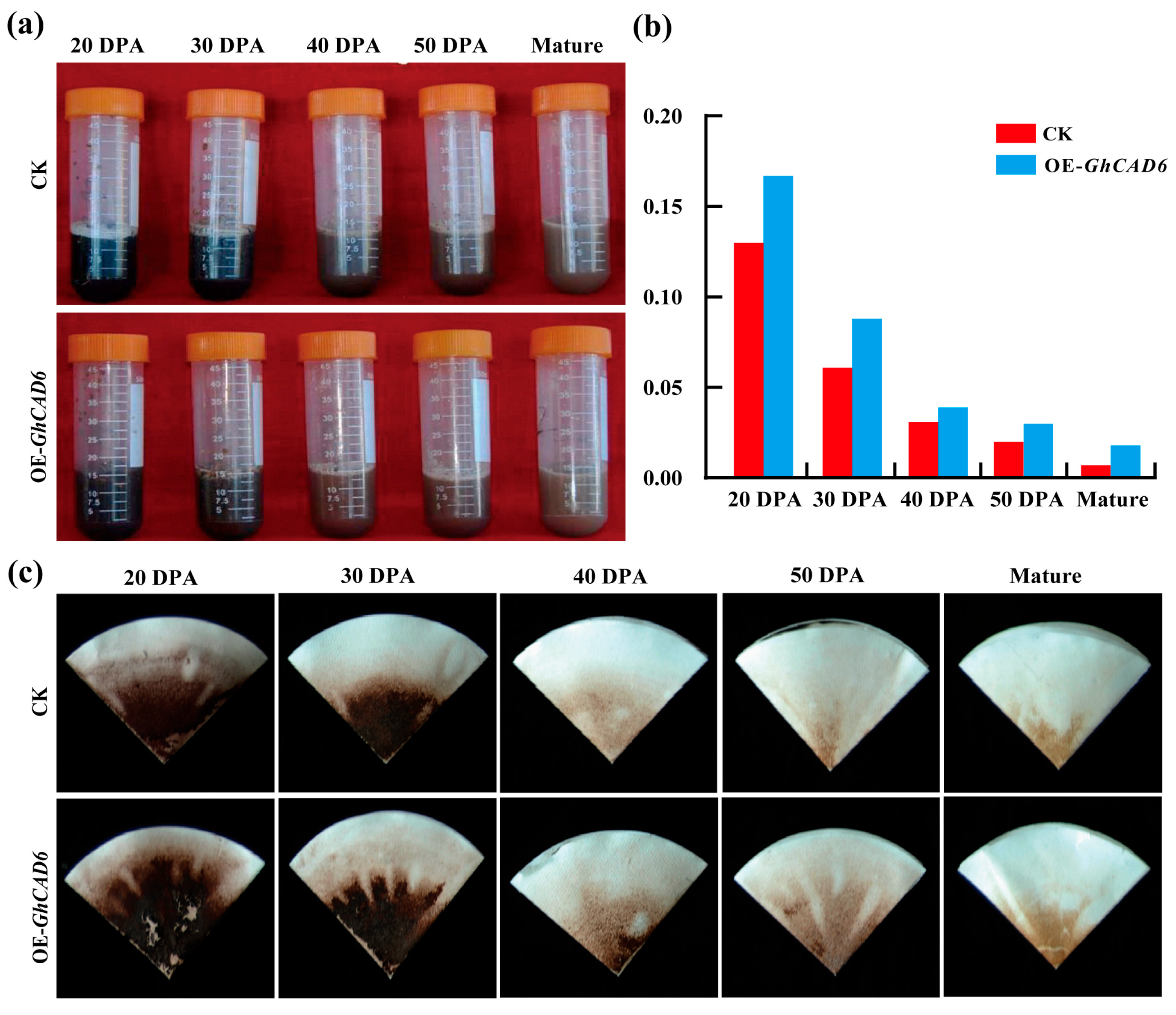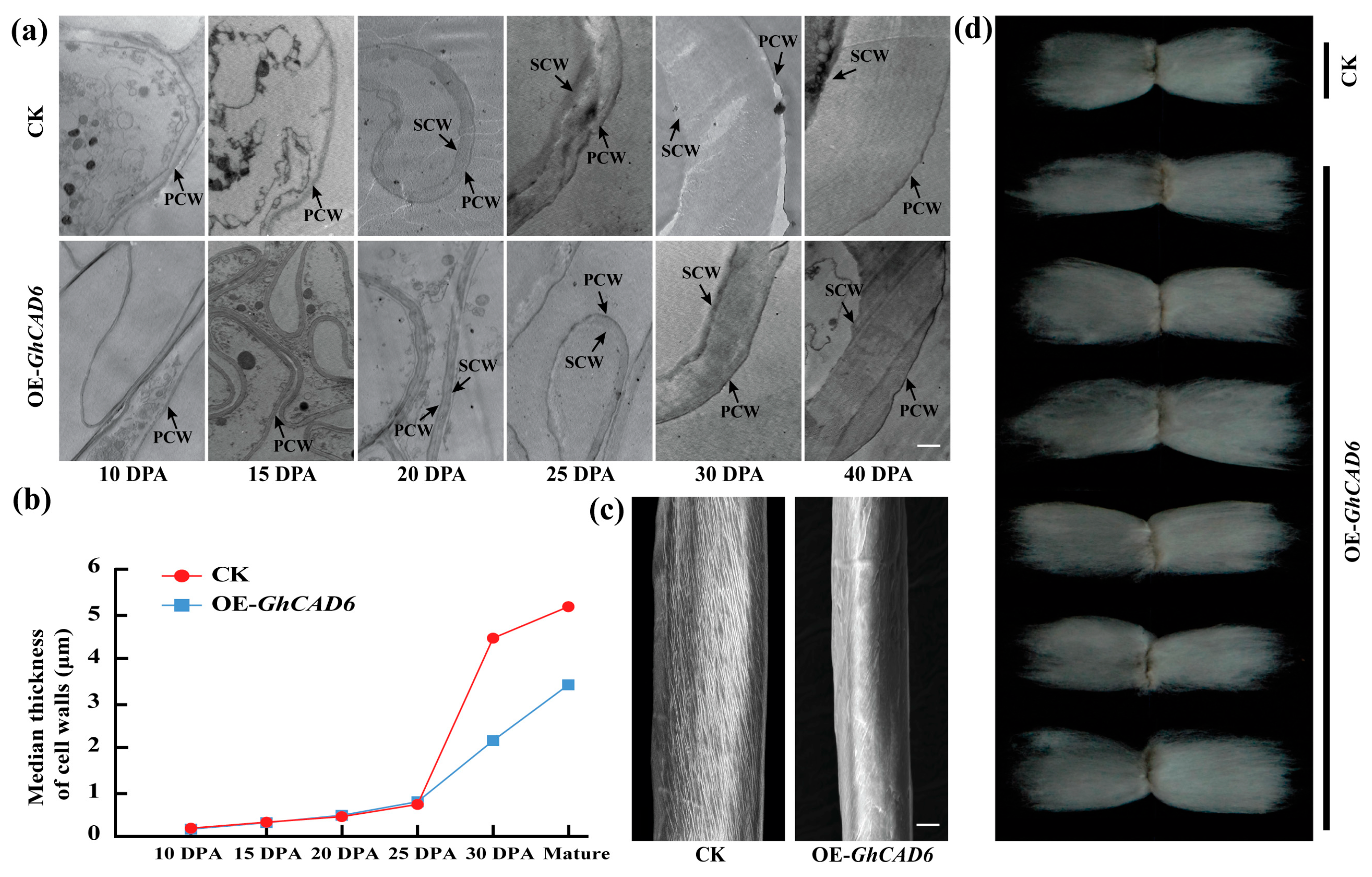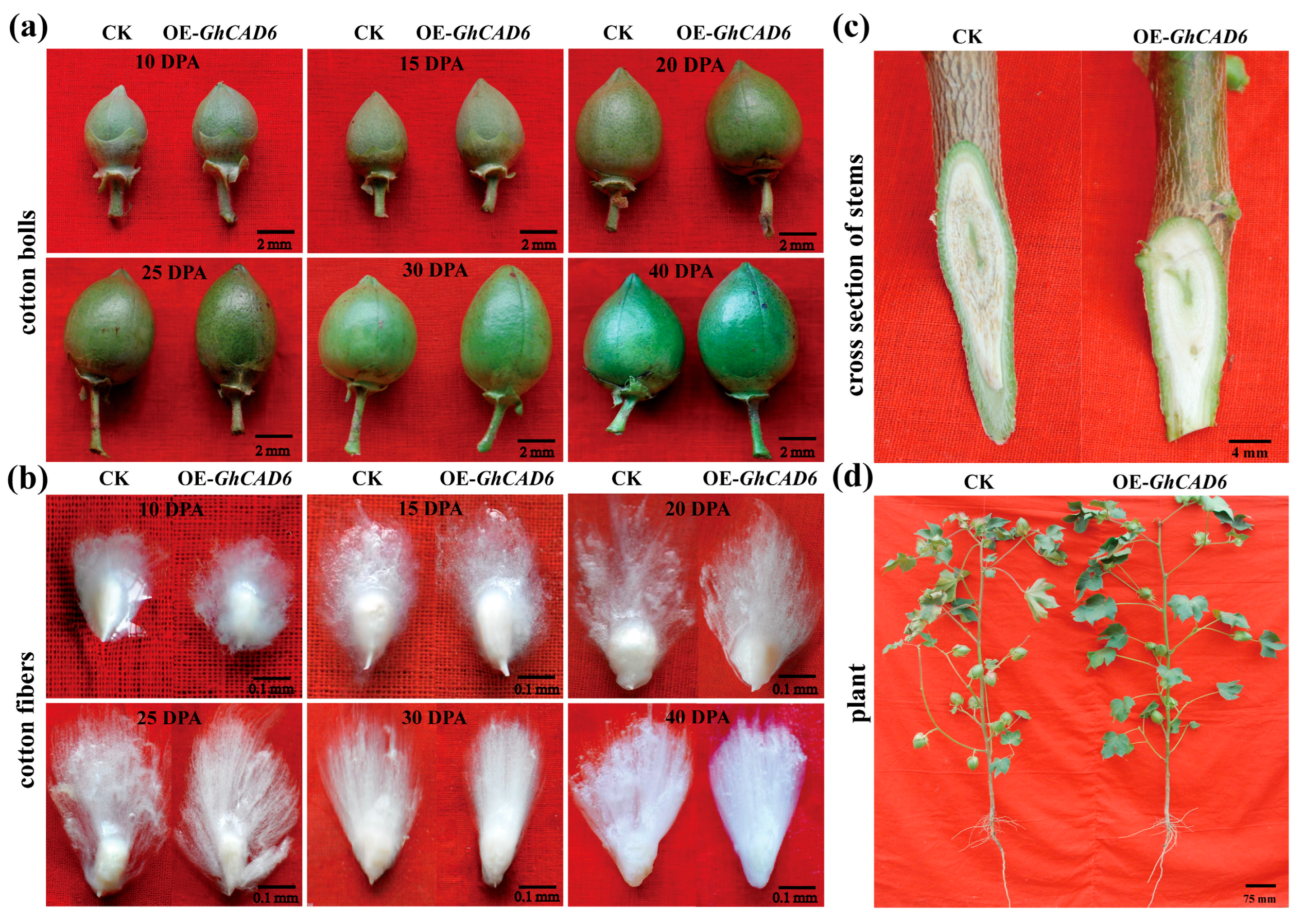Overexpression of GhCAD6 in Upland Cotton (Gossypium hirsutum L.) Enhances Fiber Quality and Increases Lignin Content in Fibers
Abstract
1. Introduction
2. Results
2.1. Cloning of GhCAD6 Gene and Identification of Overexpression Plants
2.2. Expression Analysis of GhCAD6 During Cotton Fiber Development
2.3. GhCAD6 Regulates Lignin Synthesis in Cotton Fiber
2.4. GhCAD6 Regulates the Synthesis of Cotton Fiber Cell Wall
2.5. Observation of Agronomic Traits of Plants Overexpressing GhCAD6
2.6. Analysis of Fiber Quality Parameters of GhCAD6-Overexpressing Plants
3. Discussion
3.1. GhCAD6 Participates in Lignin Synthesis
3.2. The Lignin Content Influences the Formation of Fiber Quality
3.3. An Increase in Lignin Content Will Increase Plant Disease Resistance
4. Materials and Methods
4.1. Clone of GhCAD6 Gene and Construction of Overexpression Vector
4.2. Detection of Transgenic Plants
4.3. Southern Blotting
4.4. RNA Extraction and Expression Analysis of GhCAD6 Gene
4.5. Determination of Lignin Content in Plants
4.6. Analysis of Cell Wall Structure and Fiber Properties
4.7. Analysis of Agronomic Traits of Plants
5. Conclusions
Supplementary Materials
Author Contributions
Funding
Institutional Review Board Statement
Informed Consent Statement
Data Availability Statement
Conflicts of Interest
References
- Gao, X.P.; Guo, H.H.; Zhang, Q.; Guo, H.X.; Zhang, L.; Zhang, C.Y.; Gou, Z.Y.; Liu, Y.; Wei, J.M.; Chen, A.Y.; et al. Arbuscular mycorrhizal fungi (AMF) enhanced the growth, yield, fiber quality and phosphorus regulation in upland cotton (Gossypium hirsutum L.). Sci. Rep. 2020, 10, 2084. [Google Scholar] [CrossRef]
- Ma, Q.F.; Wu, C.H.; Wu, M.; Pei, W.F.; Li, X.L.; Wang, W.K.; Zhang, J.F.; Yu, J.W.; Yu, S.X. Integrative transcriptome, proteome, phosphoproteome and genetic mapping reveals new aspects in a fiberless mutant of cotton. Sci. Rep. 2016, 6, 24485. [Google Scholar] [CrossRef]
- Ceylan, Ö.; Landuyt, L.V.; Meulewaeter, F.; Clerck, K.D. Moisture sorption in developing cotton fibers. Cellulose 2012, 19, 1517–1526. [Google Scholar] [CrossRef]
- Haigler, C.H.; Betancur, L.; Stiff, M.R.; Tuttle, J.R. Cotton fiber: A powerful single-cell model for cell wall and cellulose research. Front. Plant Sci. 2012, 3, 104. [Google Scholar] [CrossRef] [PubMed]
- Kor, S.D.; Chowdhury, N.; Keot, A.K.; Yogendra, K.; Chikkaputtaiah, C.; Sudhakar, R.P. RNA Pol III promoters—Key players in precisely targeted plant genome editing. Front. Genet. 2023, 13, 989199. [Google Scholar] [CrossRef]
- Basra, A.S.; Malik, C.P. Development of the cotton fiber. Int. Rev. Cytol. 1984, 89, 65–113. [Google Scholar]
- Meinert, M.C.; Delmer, D.P. Changes in biochemical composition of the cell wall of the cotton fiber during development. Plant Physiol. 1977, 59, 1088–1097. [Google Scholar] [CrossRef] [PubMed]
- Bethke, G.; Thao, A.; Xiong, G.; Li, B.; Soltis, N.E.; Hatsugai, N.; Hillmer, R.A.; Katagiri, F.; Kliebenstein, D.J.; Pauly, M.; et al. Pectin biosynthesis is critical for cell wall integrity and immunity in Arabidopsis thaliana. Plant Cell 2016, 28, 537–556. [Google Scholar] [CrossRef]
- Fan, S.M.; Liu, A.Y.; Zou, X.Y.; Zhang, Z.; Ge, Q.; Gong, W.K.; Li, J.W.; Gong, J.W.; Shi, Y.Z.; Deng, X.Y.; et al. Evolution of pectin synthesis relevant galacturonosyltransferase gene family and its expression during cotton fiber development. J. Cotton Res. 2021, 4, 22. [Google Scholar] [CrossRef]
- Pancaldi, F.; van Loo, E.N.; Schranz, M.E.; Trindade, L.M. Genomic architecture and evolution of the cellulose synthase gene superfamily as revealed by phylogenomic analysis. Front. Plant Sci. 2022, 13, 870818. [Google Scholar]
- Zhang, L.; Wen, X.P.; Chen, X.; Zhou, Y.F.; Wang, K.; Zhu, Y.X. GhCASPL1 regulates secondary cell wall thickening in cotton fibers by stabilizing the cellulose synthase complex on the plasma membrane. J. Integr. Plant Biol. 2024, 66, 2632–2647. [Google Scholar] [CrossRef] [PubMed]
- Battle, M.; Bender, M.L.; Tans, P.P.; White, J.W.; Ellis, J.T.; Conway, T.; Francey, R.J. Global carbon sinks and their variability inferred from atmospheric O2 and δ13C. Science 2000, 287, 2467–2470. [Google Scholar] [CrossRef]
- Chou, E.Y.; Schuetz, M.; Hoffmann, N.; Watanabe, Y.; Sibout, R.; Samuels, A.L. Distribution, mobility, and anchoring of lignin-related oxidative enzymes in Arabidopsis secondary cell walls. J. Exp. Bot. 2018, 69, 1849–1859. [Google Scholar] [CrossRef]
- Lee, M.H.; Jeon, H.S.; Kim, S.H.; Chung, J.H.; Roppolo, D.; Lee, H.J.; Cho, H.J.; Tobimatsu, Y.; Ralph, J.; Park, O.K. Lignin-based barrier restricts pathogens to the infection site and confers resistance in plants. EMBO J. 2019, 38, e101948. [Google Scholar] [CrossRef] [PubMed]
- Meents, M.J.; Watanabe, Y.; Samuels, A.L. The cell biology of secondary cell wall biosynthesis. Ann. Bot. 2018, 121, 1107–1125. [Google Scholar] [CrossRef]
- Uddin, N.; Li, X.; Ullah, M.W.; Sethupathy, S.; Ma, K.; Zahoor, E.N.; Elboughdiri, N.; Khan, K.A.; Zhu, D. Lignin developmental patterns and Casparian strip as apoplastic barriers: A review. Int. J. Biol. Macromol. 2024, 260, 129595. [Google Scholar] [CrossRef]
- Kim, H.J.; Triplett, B.A. Cotton fiber growth in planta and in vitro. Models for plant cell elongation and cell wall biogenesis. Plant Physiol. 2001, 127, 1361–1366. [Google Scholar] [CrossRef]
- Al-Ghazi, Y.; Bourot, S.; Arioli, T.; Dennis, E.S.; Llewellyn, D.J. Transcript profiling during fiber development identifies pathways in secondary metabolism and cell wall structure that may contribute to cotton fiber quality. Plant Cell Physiol. 2007, 50, 1364–1381. [Google Scholar] [CrossRef]
- Gou, J.Y.; Wang, L.J.; Chen, S.P.; Hu, W.L.; Chen, X.Y. Gene expression and metabolite profiles of cotton fiber during cell elongation and secondary cell wall synthesis. Cell Res. 2007, 17, 422–434. [Google Scholar] [CrossRef] [PubMed]
- Xu, L.; Zhu, L.F.; Tu, L.L.; Liu, L.L.; Yuan, D.J.; Jin, L.; Long, L.; Zhang, X.L. Lignin metabolism has a central role in the resistance of cotton to the wilt fungus Verticillium dahliae as revealed by RNA-Seq-dependent transcriptional analysis and histochemistry. J. Exp. Bot. 2011, 62, 5607–5621. [Google Scholar] [CrossRef]
- Gao, Z.Y.; Sun, W.J.; Wang, J.; Zhao, C.Y.; Zuo, K.J. GhbHLH18 negatively regulates fiber strength and length by enhancing lignin biosynthesis in cotton fibers. Plant Sci. 2019, 286, 7–16. [Google Scholar] [CrossRef]
- Wyrambik, D.; Grisebach, H. Purification and properties of isoenzymes of cinnamyl-alcohol dehydrogenase from soybean-cell-suspension cultures. Eur. J. Biochem. 1975, 59, 9–15. [Google Scholar] [CrossRef] [PubMed]
- Dong, N.Q.; Lin, H.X. Contribution of phenylpropanoid metabolism to plant development and plant-environment interactions. J. Integr. Plant Biol. 2021, 63, 180–209. [Google Scholar] [CrossRef] [PubMed]
- Mansell, R.L.; Georg, G.G.; Stöckigt, J.; Franke, H.; Zenk, M.H. Purification and properties of cinnamyl alcohol dehydrogenase from higher plants involved in lignin biosynthesis. Phytochemistry 1974, 13, 2427–2435. [Google Scholar] [CrossRef]
- Kim, S.J.; Kim, M.R.; Bedgar, D.L.; Moinuddin, S.G.; Cardenas, C.L.; Davin, L.B.; Kang, C.; Lewis, N.G. Functional reclassification of the putative cinnamyl alcohol dehydrogenase multigene family in Arabidopsis. Proc. Natl. Acad. Sci. USA 2004, 101, 1455–1460. [Google Scholar] [CrossRef]
- Wu, M.Z.; Li, Y.J.; Liu, Z.T.; Xia, L.; Xiang, Y.Y.; Zhao, L.J.; Yang, X.B.; Li, Z.F.; Xie, X.D.; Wang, L.; et al. Genome-wide identification of the CAD gene family and functional analysis of putative bona fide CAD genes in tobacco (Nicotiana tabacum L.). Front. Plant Sci. 2024, 15, 1400213. [Google Scholar] [CrossRef]
- Zhang, X.; Wang, Z.Y.; Zhong, X.Y.; Fu, W.W.; Li, Y.X.; Liusui, Y.H.; Guo, Y.J.; Zhang, J.B.; Li, B. Genome-wide identification of the Gossypium hirsutum CAD gene family and functional study of GhiCAD23 under drought stress. PeerJ 2024, 12, e18439. [Google Scholar] [CrossRef]
- Chao, N.; Huang, S.; Kang, X.R.; Yidilisi, K.; Dai, M.J.; Liu, L. Systematic functional characterization of cinnamyl alcohol dehydrogenase family members revealed their functional divergence in lignin biosynthesis and stress responses in mulberry. Plant. Physiol. Biochem. 2022, 186, 145–156. [Google Scholar] [CrossRef]
- Hu, L.; Zhang, X.; Ni, H.H.; Yuan, F.; Zhang, S.M. Identification and functional analysis of CAD gene family in pomegranate (Punica granatum). Gene 2022, 14, 26. [Google Scholar] [CrossRef]
- Sibout, R.; Eudes, A.; Mouille, G.; Pollet, B.; Lapierre, C.; Jouanin, L.; Séguin, A. CINNAMYL ALCOHOL DEHYDROGENASE-C and-D are the primary genes involved in lignin biosynthesis in the floral stem of Arabidopsis. Plant Cell 2005, 17, 2059–2076. [Google Scholar] [CrossRef] [PubMed]
- Sirisha, V.L.; Prashant, S.; Ranadheer, K.D.; Pramod, S.; Jalaja, N.; Hima, K.P.; Rao, M.P.; Rao, N.S.; Mishra, P.; Rao, K.S.; et al. Cloning, characterization and impact of up- and down-regulating subabul cinnamyl alcohol dehydrogenase (CAD) gene on plant growth and lignin profiles in transgenic tobacco. Plant Growth Regul. 2012, 66, 239–253. [Google Scholar] [CrossRef]
- Xun, H.W.; Qian, X.Y.; Wang, M.; Yu, J.X.; Zhang, X.; Pang, J.S.; Wang, S.C.; Jiang, L.J.; Dong, Y.S.; Liu, B. Overexpression of a Cinnamyl Alcohol Dehydrogenase-Coding Gene, GsCAD1, from Wild Soybean Enhances Resistance to Soybean Mosaic Virus. Int. J. Mol. Sci. 2022, 23, 15206. [Google Scholar] [CrossRef]
- Jiang, S.; Tian, X.; Huang, X.L.; Xin, J.K.; Yan, H.Q. Physcomitrium patens CAD1 has distinct roles in growth and resistance to biotic stress. BMC Plant Biol. 2022, 22, 518. [Google Scholar] [CrossRef]
- Deng, W.W.; Zhang, M.; Wu, J.Q.; Jiang, Z.Z.; Tang, L.; Li, Y.Y.; Wei, C.L.; Jiang, C.J.; Wan, X.C. Molecular cloning, functional analysis of three cinnamyl alcohol dehydrogenase (CAD) genes in the leaves of tea plant, Camellia sinensis. J. Plant Physiol. 2013, 170, 272–282. [Google Scholar] [CrossRef]
- Han, L.B.; Li, Y.B.; Wang, H.Y.; Wu, X.M.; Li, C.L.; Luo, M.; Wu, S.J.; Kong, Z.S.; Pei, Y.; Jiao, G.L.; et al. The dual functions of WLIM1a in cell elongation and secondary wall formation in developing cotton fibers. Plant Cell 2013, 25, 4421–4438. [Google Scholar] [CrossRef] [PubMed]
- Fan, L.; Linker, R.; Gepstein, S.; Tanimoto, E.; Yamamoto, R.; Neumann, P.M. Progressive inhibition by water deficit of cell wall extensibility and growth along the elongation zone of maize roots is related to increased lignin metabolism and progressive stelar accumulation of wall phenolics. Plant Physiol. 2006, 140, 603–612. [Google Scholar] [CrossRef] [PubMed]
- Miedes, E.; Vanholme, R.; Boerjan, W.; Molina, A. The role of the secondary cell wall in plant resistance to pathogens. Front. Plant Sci. 2014, 5, 358. [Google Scholar] [CrossRef] [PubMed]
- Porebski, S.; Bailey, L.G.; Baum, B.R. Modification of a CTAB DNA extraction protocol for plants containing high polysaccharide and polyphenol components. Plant Mol. Biol. Rep. 1997, 15, 8–15. [Google Scholar] [CrossRef]
- Pfaffl, M.W. A new mathematical model for relative quantification in real-time RT–PCR. Nucleic Acids Res. 2001, 29, e45. [Google Scholar] [CrossRef]
- Lee, S.; Rajasekaran, K.; Ramanarao, M.V.; Bedre, R.; Bhatnagar, D.; Baisakh, N. Identifying cotton (Gossypium hirsutum L.) genes induced in response to Aspergillus flavus infection. Physiol. Mol. Plant Pathol. 2012, 80, 35–40. [Google Scholar] [CrossRef]
- Hatfield, R.; Fukushima, R.S. Can lignin be accurately measured? Crop Sci. 2005, 45, 832–839. [Google Scholar] [CrossRef]






Disclaimer/Publisher’s Note: The statements, opinions and data contained in all publications are solely those of the individual author(s) and contributor(s) and not of MDPI and/or the editor(s). MDPI and/or the editor(s) disclaim responsibility for any injury to people or property resulting from any ideas, methods, instructions or products referred to in the content. |
© 2025 by the authors. Licensee MDPI, Basel, Switzerland. This article is an open access article distributed under the terms and conditions of the Creative Commons Attribution (CC BY) license (https://creativecommons.org/licenses/by/4.0/).
Share and Cite
Tuerxun, Z.; Li, C.; Li, X.; Li, Y.; Qin, X.; Zhang, H.; Yang, Y.; Chen, G.; Li, J.; Liu, Z.; et al. Overexpression of GhCAD6 in Upland Cotton (Gossypium hirsutum L.) Enhances Fiber Quality and Increases Lignin Content in Fibers. Int. J. Mol. Sci. 2025, 26, 9518. https://doi.org/10.3390/ijms26199518
Tuerxun Z, Li C, Li X, Li Y, Qin X, Zhang H, Yang Y, Chen G, Li J, Liu Z, et al. Overexpression of GhCAD6 in Upland Cotton (Gossypium hirsutum L.) Enhances Fiber Quality and Increases Lignin Content in Fibers. International Journal of Molecular Sciences. 2025; 26(19):9518. https://doi.org/10.3390/ijms26199518
Chicago/Turabian StyleTuerxun, Zumuremu, Chenyu Li, Xiaorong Li, Yuanxin Li, Xinxin Qin, Hui Zhang, Yang Yang, Guo Chen, Juan Li, Zhigang Liu, and et al. 2025. "Overexpression of GhCAD6 in Upland Cotton (Gossypium hirsutum L.) Enhances Fiber Quality and Increases Lignin Content in Fibers" International Journal of Molecular Sciences 26, no. 19: 9518. https://doi.org/10.3390/ijms26199518
APA StyleTuerxun, Z., Li, C., Li, X., Li, Y., Qin, X., Zhang, H., Yang, Y., Chen, G., Li, J., Liu, Z., Chen, X., Cai, D., & Li, B. (2025). Overexpression of GhCAD6 in Upland Cotton (Gossypium hirsutum L.) Enhances Fiber Quality and Increases Lignin Content in Fibers. International Journal of Molecular Sciences, 26(19), 9518. https://doi.org/10.3390/ijms26199518





